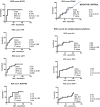"Liquid Biopsy" of White Matter Hyperintensity in Functionally Normal Elders
- PMID: 30483114
- PMCID: PMC6244607
- DOI: 10.3389/fnagi.2018.00343
"Liquid Biopsy" of White Matter Hyperintensity in Functionally Normal Elders
Abstract
Background and Objective: In the aging brain, increased blood-brain barrier (BBB) leakage and white matter hyperintensity (WMH) on MRI are frequently presumed secondary to cerebral small vessel disease (cSVD) or endotheliopathy. We investigate this association in vivo by quantifying protein cargo from endothelial-derived exosomes (EDE), and comparing levels between two groups of functionally normal elders with and without WMH. In addition, we study associations of EDE proteins with upstream and downstream factors, such as inflammation and neurodegenerative changes, respectively. Methods: Twenty six neurologically normal older adults completed general health questionnaires, neuropsychological and physical examinations, and brain MRI. WMH was visually graded with modified Fazekas score of 2 or greater used to classify 11 subjects as cases, and 15 without WMH as controls. Plasma total exosomes were precipitated and EDEs enriched by sequential immuno-precipitations. In addition, we quantified three inflammatory cytokines from plasma and imaging variables on MRI. Group means were compared, the discriminant functions of biomarkers calculated, and the association of EDE biomarkers with plasma inflammatory markers, cognition, and imaging outcomes assessed via regression modeling. Results: Plasma levels of EDE cargo proteins GLUT1, LAT1, P-GP, and NOSTRIN were significantly higher in subjects with WMH in comparison to those without. In contrast, EDE levels of the marker with low expression in brain (VCAM1) were equal between groups. The effect sizes for each of the brain-expressed cargo proteins (GLUT1, LAT1, and P-GP) were such that age-adjusted logistic regressions revealed areas under the curve (AUC) with range of 0.82-0.89, differentiating subjects with WMH from those without. VCAM1 poorly discriminated between groups (AUC:0.55). Higher levels of all brain-expressed EDE proteins were also associated with lower cognitive function, unrelated to burden of WMH. Levels of LAT1 and P-GP were significantly inversely associated with global gray matter volumes, and EDE GLUT1, LAT-1, and P-GP concentrations were significantly associated with systemic IL-6 levels. Conclusion: In a case control study of clinically normal adults with and without WMH, concentrations of EDE proteins were significantly higher in subjects with WMH in comparison to controls. This work is a first step toward in vivo dissection of molecular changes in endothelia of functionally normal subjects with radiographic evidence of age-associated white matter disease.
Keywords: biomarkers; cerebral small vessel disease; exosomes; extracellular vesicles; inflammation; white matter.
Figures




Similar articles
-
Elevated complement mediator levels in endothelial-derived plasma exosomes implicate endothelial innate inflammation in diminished brain function of aging humans.Sci Rep. 2021 Aug 10;11(1):16198. doi: 10.1038/s41598-021-91759-2. Sci Rep. 2021. PMID: 34376699 Free PMC article.
-
Blood-brain barrier leakage in relation to white matter hyperintensity volume and cognition in small vessel disease and normal aging.Brain Imaging Behav. 2019 Apr;13(2):389-395. doi: 10.1007/s11682-018-9855-7. Brain Imaging Behav. 2019. PMID: 29572621 Free PMC article.
-
Value of white matter hyperintensity volume and total white matter volume for evaluating cognitive impairment in patients with cerebral small-vessel disease.Front Aging Neurosci. 2023 Mar 31;15:1096808. doi: 10.3389/fnagi.2023.1096808. eCollection 2023. Front Aging Neurosci. 2023. PMID: 37065461 Free PMC article.
-
Heterogeneity of White Matter Hyperintensity and Cognitive Impairment in Patients with Acute Lacunar Stroke.Brain Sci. 2022 Dec 6;12(12):1674. doi: 10.3390/brainsci12121674. Brain Sci. 2022. PMID: 36552134 Free PMC article.
-
Compromised Blood-Brain Barrier Integrity Is Associated With Total Magnetic Resonance Imaging Burden of Cerebral Small Vessel Disease.Front Neurol. 2018 Apr 6;9:221. doi: 10.3389/fneur.2018.00221. eCollection 2018. Front Neurol. 2018. PMID: 29681883 Free PMC article.
Cited by
-
The Multifaceted Role of L-Type Amino Acid Transporter 1 at the Blood-Brain Barrier: Structural Implications and Therapeutic Potential.Mol Neurobiol. 2025 Mar;62(3):3813-3832. doi: 10.1007/s12035-024-04506-9. Epub 2024 Sep 26. Mol Neurobiol. 2025. PMID: 39325101 Review.
-
Biomarker potential of brain-secreted extracellular vesicles in blood in Alzheimer's disease.Alzheimers Dement (Amst). 2020 Mar 5;12(1):e12001. doi: 10.1002/dad2.12001. eCollection 2020. Alzheimers Dement (Amst). 2020. PMID: 32211497 Free PMC article. Review.
-
The Brain's Microvascular Response to High Glycemia and to the Inhibition of Soluble Epoxide Hydrolase Is Sexually Dimorphic.Nutrients. 2022 Aug 23;14(17):3451. doi: 10.3390/nu14173451. Nutrients. 2022. PMID: 36079709 Free PMC article.
-
Decreased visible deep medullary veins is a novel imaging marker for cerebral small vessel disease.Neurol Sci. 2020 Jun;41(6):1497-1506. doi: 10.1007/s10072-019-04203-9. Epub 2020 Jan 18. Neurol Sci. 2020. PMID: 31955350
-
Elevated complement mediator levels in endothelial-derived plasma exosomes implicate endothelial innate inflammation in diminished brain function of aging humans.Sci Rep. 2021 Aug 10;11(1):16198. doi: 10.1038/s41598-021-91759-2. Sci Rep. 2021. PMID: 34376699 Free PMC article.
References
-
- Bos I., Verhey F. R., Ramakers I. H. G. B., Jacobs H. I. L., Soininen H., Freund-Levi Y., et al. (2017). Cerebrovascular and amyloid pathology in predementia stages: the relationship with neurodegeneration and cognitive decline. Alzheimers Res. Ther. 9:101. 10.1186/s13195-017-0328-9 - DOI - PMC - PubMed
Grants and funding
LinkOut - more resources
Full Text Sources
Research Materials
Miscellaneous

